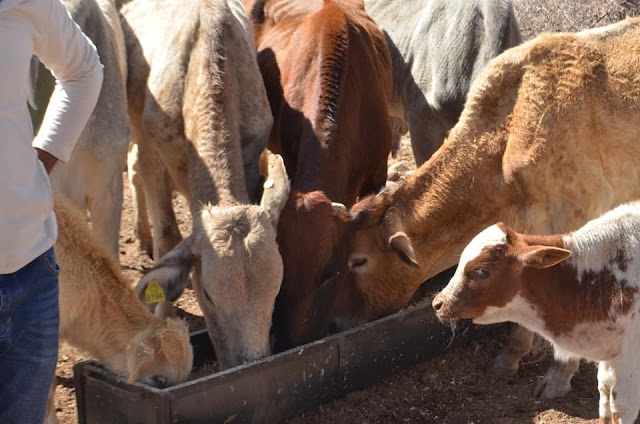- Underfeeding
- Overfeeding
- Not dividing the herd into different feeding groups
- Zero watering or providing low quantities of water
Solutions
When feeding it is important to know
dry matter intake which is given in animal nutrition formulae. It is important
in calculating how much feed your animal will consume. Dry matter content found
on the leaflet of the feedstuffs we as farmers buy, help in these calculations.
Dry
matter is the amount of feedstuff remaining after all the free moisture is
evaporated out.
- Calculating dry matter helps reduce feeding losses and improve feeding efficiency
- It also helps in dividing the herd into different feeding groups
- It gives great opportunity to reduce feeding costs
Always compare feedstuffs on dry matter
basis for:
- All budget exercises
- Ration formulation
- Purchasing of feed
Dry
matter intake is affected by quality of feed, physiology of the animal,
environmental factors, stress and diseases.
In addition, it is important to know
the primary limiting nutrients when feeding. In wet seasons as we are going
into wet season, it is phosphorus and in dry season it is protein and energy.
Protein requirements for cattle is
around 0.25kg and 0.55kg.
Let us look at an example so we can all understand.
A particular calf grower on the leaflet
indicates 878.6g/kg of dry matter. Meaning it contains 87.8% dry matter.
Therefore, cattle, sheep and goats
consume 3% of their body weight. Let's take for example a calf weighing 100kg,this
means it will consume 3kg in a day and of that feedstuff it will consume
3kg/87.8% which is 3.414kg
In that feed there is 125g/kg of protein meaning that 40kg bag has 5kg protein. Moreover, if the calf feeds 3.5kg of that feed, it has fed on 0.4375kg of protein and has meet the requirements.
If we have 50 calves that means in a
day they will feed on 170kg, which is approximately four bags of 40kg calf
growers in a day.
If you cannot understand how to feed
your livestock, please always ask for help, protect your wealth and do not let
your livestock die, we have animal nutritionists in the field.
We experienced high death mortality due
to feeding mistakes. Please, next time let us avoid these.
You do not have to go to buy feed alone, take an animal nutritionist with you, or have them compare feeds for you beforehand.

.jpg)
Comments
Post a Comment